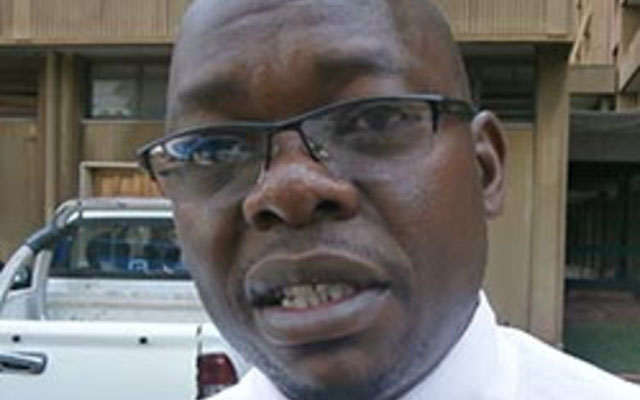Late detection of eye cancer major killer of children


Eye specialists say retinoblastoma is a very treatable cancer but is often diagnosed too late to save a child’s eye
Sifelani Tsiko Senior Writer
The late detection of retinoblastoma, an unusual form of eye cancer which affects the retina of children aged under five, is one of the leading causes of death among children who are admitted at the Sekuru Kaguvi Hospital (SKH), an eye specialist says.
Pamidzai Madzima, an eye specialist who earlier this year won the Medical Research Council of Zimbabwe (MRCZ) overall best prize for the best paper that focused on presentation patterns of retinoblastoma (the most common malignant cancer of the eye in children) at Sekuru Kaguvi Hospital, says it is worrying that most parents come with their children to the hospital when the disease has reached an advanced stage.
“Patients present to SKH late with advanced disease and this results in high deaths of children,” she says.
“Retinoblastoma can result in the eye being removed if there is any delay in treating it. Early detection greatly increases the chances for successful treatment and we need to conduct more awareness campaigns to inform the public about this condition.”
Madzima was one of eight medical students and researchers who were recognised for their outstanding academic achievements at the Annual Medical Research Day awards ceremony held earlier this year at the University of Zimbabwe — Institute of Continuing Health Education (ICHE).
The researchers walked away with certificates, trophies and cash prizes for researching into various issues affecting the health sector in the country. A study by Madzima carried out at SKH showed that retinoblastoma was the second most common cause of deaths at the institution.
The study involved gleaning of data from medical records of patients admitted to SKH from January 1, 2010 to December 31, 2014 and the reviewing of eye cancer histological results. The mean age of patients was 33 months. A total of 87 patients were examined and about 42 of them died within the study period. Two thirds of the cases were unilateral.
Unilateral retinoblastoma occurs in one eye, while bilateral retinoblastoma occurs in both eyes. The eye researcher found that orbital recurrence was 27 percent and mortality was 61,8 percent.
Madzima said deaths from childhood eye cancer was associated with proptosis (protrusion of the eyeball), older age at presentation, female gender, bilateral disease and exposure to HIV.
Childhood eye cancer is the most common malignancy among children in Zimbabwe and the country is estimated to have the third highest incidence in the world. To prevent deaths, Madzima says there is need to promote awareness, early detection of eye cancer and education to promote early diagnosis and screening.
“Retinoblastoma is diagnosed late and this might account for the relatively high frequency of the eye disease reports,” she says. Eye health experts say the majority of children with retinoblastoma in Africa are diagnosed too late and many have no easy access to treatment. Problems encountered included delayed diagnosis, inappropriate, inconsistent or incomplete medical care.
“Parents must seek help early from professional health experts,” says Madzima. “Many people delay to come because they will be seeking help from traditional or faith healers. Late referrals also make it difficult for treatment.”
Other experts further say both late consultation by parents, especially those with a poor educational background and a lack of awareness by paediatricians (experts who deal with the care of infants, children, and adolescents) and ophthalmologists (eye and vision experts) contributed to the delays which often led to the death of children.
“We believe everyone should know that children can get cancer in their eyes and what the signs are, and we have to work hard to raise awareness among health professionals and the public in this country,” says another eye specialist at SKH.
“The public needs to know what are the symptoms. We need to carry out aggressive campaigns to help save lives.” Health experts say the most common sign of retinoblastoma is a white glow in the pupil of the eye. They say the ‘glow’ is caused by the light reflecting off the tumour at the back of the child’s eye.
The unusual white reflection in the pupil of the eye, they say, may be apparent in photos. In others, they say, are a squint, a change in the colour of the iris and a red or inflamed eye, which is not usually accompanied by pain. In about 40 percent of cases, retinoblastoma is caused by a faulty gene, which often affects both eyes. Experts still don’t know what causes the remaining 60 percent of cases.
“We feel the NHS has a duty to inform parents about the disease to avoid a delay in diagnosis.” Chemotherapy is the standard treatment for retinoblastoma while in some cases laser therapy and radiotherapy can be tried. Statistics from a Canadian based eye cancer institute show more than 2 000 children develop retinoblastoma each year across Africa, compared to 280 in the US, 45 in the UK and 23 in Canada.
It estimates the survival rate in Africa to be less than 10 percent, compared with 97 percent in developed countries such as the US, UK and Canada. Experts say most children with eye cancer who begin treatment before the retinoblastoma has spread beyond the eye are cured. Preserving vision in the affected children is a top priority for most eye health institution.
Media reports say up to 50 children a year in the UK are diagnosed with retinoblastoma and 98 percent are successfully treated. But many in Zimbabwe and across Africa have their eyes removed to save their life due to delayed diagnosis. The tumour grows quite quickly and if parents delay to take their child to specialist, then the child can lose their eye.
“We need more awareness campaigns and screening programmes to be put in place to educate the public about the importance of early detection.” Eye specialists say retinoblastoma is a very treatable cancer but is often diagnosed too late to save a child’s eye. This, they say, is mainly because parents don’t have the information which could lead them to seek help earlier.
“It is vital that every parent is aware of what to look out for so that should their child show any of the signs of this eye cancer, they can easily seek urgent medical attention as early as possible to prevent unnecessary deaths,” says an eye specialists from Harare.
Delayed screening can mean loss of one or both eyes, a visual impairment and in some cases lead to complete blindness. Madzima says her study was limited in scope but a national study could help capture the prevalence of eye cancer in children and help inform decision makers in the country’s health sector.
University of Zimbabwe ophthalmologists (vision and eye science) estimate that 1,3 million Zimbabweans are blind and the majority will end up developing common vision-loss due to cataract related ailments.
They also say over 10 000 per million children have refractive errors which is a condition whereby they cannot focus parallel rays of light on the retina. Worldwide, the World Health Organisation says about 285 million people are visually impaired while 39 million are blind and 246 million have low vision.
About 90 percent of the world’s blind live in developing countries. More than eight million people die from cancer each year globally – more than AIDS, malaria and tuberculosis put together, the charity warned. Cancer is emerging as a major public health concern in Zimbabwe together with cardio-vascular diseases, diabetes and chronic respiratory diseases.
Cancer is emerging as a major public health concern in Zimbabwe together with cardio-vascular diseases, diabetes and chronic respiratory diseases. The rate of cancer among Zimbabweans is rising and the growth rate is now several times higher in recent years than it was 20 years ago, according to findings by the Zimbabwe Cancer Registry (ZCR) in 2013.
The Zimbabwe Cancer Registry says the most common cancers among all boys (paediatrics) include Leukaemia (cancer of the blood) at 17,7 percent, Retinoblastoma (eye cancer) 13,3 percent, Kaposi sarcoma 12,2 percent and Wilms Tumour (cancer of the kidney). Among all Zimbabwean girls, Kidney cancer is relatively high at 22,6 percent followed by Retinoblastoma at 13,1 percent, brain and nervous system cancer 10,7 percent, Kaposi sarcoma 9,5 percent and Leukaemia 9,5 percent. Information on cancer cases is still confusing and disjointed.
The country has a disconnected cancer database which causes inefficiency, confusion and ineffectiveness in the fight against the disease which is now a major health concern. Cases which are being recorded are for the two major hospitals in Harare and Bulawayo. The majority of patients with cancer in other towns and rural areas remain unaccounted for.










Comments